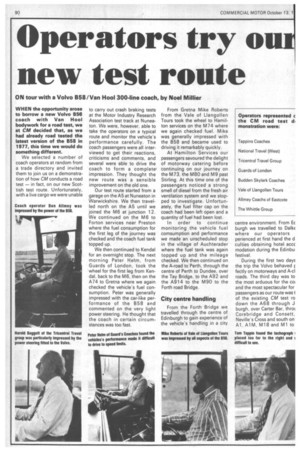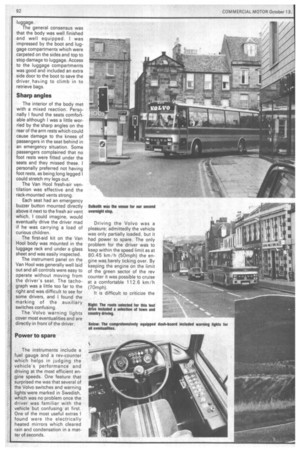Operators try ou new test route
Page 92

Page 93

Page 94

Page 95

If you've noticed an error in this article please click here to report it so we can fix it.
ON tour with a Volvo B58/Van Hool 300-line coach, by Noel Millier WHEN the opportunity arose to borrow a new Volvo B58 coach with Van Hool bodywork for a road test, we at CM decided that, as we had already road tested the latest version of the B58 in 1977, this time we would do something different.
We selected a number of coach operators at random from a trade directory and invited them to join us on a demonstration of how CM conducts a road test — in fact, on our new Scottish test route. Unfortunately, with a live cargo we were unable
to carry out crash braking tests at the Motor Industry Research Association test track at Nuneaton. We were, however, able to take the operators on a typical route and monitor the vehicle's performance carefully. The coach passengers were all interviewed to get their reactions, criticisms and comments, and several were able to drive the coach to form a completeh impression. They thought the new route was a sensible improvement on the old one.
Our test route started from a garage on the 45 at Nuneaton in Warwickshire. We then travelled north on the A5 until we joined the MG at junction 12. We continued on the M6 to Forton services near Preston where the fuel consumption for the first leg of the journey was checked and the coach fuel tank topped up.
We then continued to Kendal for an overnight stop. The next morning Peter Helm, from Guards of London, took the wheel for the first leg from Kendal, back to the MG, then on the A74 to Gretna where we again checked the vehicle's fuel consumption. Peter was generally impressed with the car-like performance of the B58 and commented on the very light power steering. He thought that the coach in certain circumstances was too fast. From Gretna Mike Roberts from the Vale of Llangollen Tours took the wheel to Hamilton services on the M74 where we again checked fuel. Mike was generally impressed with the B58 and became used to driving it remarkably quickly.
At Hamilton Services our passengers savoured the delight of motorway catering before continuing on our journey on the M73, the M80 and M9 past Stirling. At this time one of the passengers noticed a strong smell of diesel from the fresh air ventilation system and we stopped to investigate. Unfortunately, the fuel filter cap on the coach had been left open and a quantity of fuel had been lost.
In order to continue monitoring the vehicle fuel comsumption and performance we made an unscheduled stop in the village of Auchterader where the fuel tank was again topped up and the mileage checked. We then continued on the A-road to Perth, through the centre of Perth to Dundee, over the Tay Bridge, to the A92 and the A914 to the M90 to the Forth road Bridge.
City centre handling
From the Forth Bridge we travelled through the centre of Edinburgh to gain experience of the vehicle's handling in a city centre environment. From Ec burgh we travelled to DalkE where our operators perienced at first hand the d culties obtaining hotel accc rnodation during the Edinbu festival.
During the first two days the trip the Volvo behaved r fectly on motorways and A-cl roads. The third day was to the most arduous for the co; and the most spectacular for passengers as our route was t of the existing CM test ro down the A68 through J burgh, over Carter Bar, throL Corebridge and Consett, Neville's Cross and south on Al, A1 M, M18 and M1 to
9 and back to our starting it at Nuneaton.
Despite strong cross-winds Volvo treated the A68 like a light, level read. It stormed the hills and was only slowed the need to keep passengers heir seats.
The coach climbed Carter Bar )nly 3min 9sec and I did not to engage a lower gear n fourth. Fuel was checked at chester in Northumberland 1 Neville's Cross in County rham.
From Neville's Cross Don mey of Allmey coaches of stcote took the wheel to Ach Corner where we stopd for lunch; from Sotch Corner Harold Baggot of Tricentrol Travel Group took the wheel. Mr Baggott commented that he found the steering on the Volvo as good as that of any coach he had driven.
We stopped for a final fuel check at the last service area on the Al after which Tom Tappin of Tappins Coaches took the wheel and thundered down the motorways to Nuneaton where we finally worked out the fuel consumption for the 1,243km (773.14-mile) round trip. The average fuel consumption was 25.22 lit/100km (11.2mpg) at an average speed of 77.2km /h (48 mph).
The fuel consumption varied remarkably little during the trip. The highest consumption recorded was 29.03 lit/100km (9.73mpg) at an average speed of 65km/ h (40.4mph) for the hilly section of road from Rochester to Neville's Cross, and the lowest consumption was recorded on the M6 and A74 between Forton and Gretna including Kendal town which was 22.42 lit/100km (12.6mpg). The average speed excluding the Kendal town section was 103.9km / h (64.6mph).
The test coach was fitted with a Van Hool 300-line body which was started by Van Hool Macardle in Dublin and completed by Van Hool in Belgium following the demise of the Irish concern.
The coach was well equipped and was fitted with a suspension driving seat, 49 reclining passenger seats with folding arm rests and magazine racks, roof-mounted air horns, electrically heated mirrors, twospeed wipers, an AM FM radio and PA, an air-powered entrance door and side lockers for luggage.
The general consensus was that the body was well finished and well equipped. I was impressed by the boot and luggage compartments which were carpeted on the sides and top to stop damage to luggage. Access to the luggage compartments was good and included an extra side door to the boot to save the driver, haNding to climb in to retrieve bags.
Sharp angles
The interior of the body met with a mixed reaction. Personally I found the seats comfortable although I was a little worried by the sharp angles on the rear of the arm rests which could cause damage to the knees of passengers in the seat behind in an emergency situation. Some passengers complained that no foot rests were fitted under the seats and they missed these. I personally preferred not having foot rests, as beingiong legged I could stretch my legs out.
The Van Hool fresh-air ventilation was effective and the rack-mounted vents strong.
Each seat had an emergency buzzer button mounted directly above it next to the fresh air vent which, I could imagine, would eventually drive the driver mad if he was carrying a load of curious children.
The first-aid kit on the Van Hool body was mounted in the luggage rack end under a glass sheet and was easily inspected.
The instrument panel on the Van Hool was generally well laid out and all controls were easy to operate without moving from the driver's seat. The tachograph was a little too far to the right and was difficult to see for some drivers, and I found the marking of the auxiliary switches confusing.
The Volvo warning lights cover most eventualities and are directly in front of the driver.
Power to spare
The instruments include a fuel gauge and a rev-counter which helps in judging the vehicle's performance and driving at the most efficient engine speeds. One feature that surprised me was that several of the Volvo switches and warning lights were marked in Swedish, which was no problem once the driver was familiar with the vehicle but confusing at first. One of the most useful extras I found were the electrically heated mirrors which cleared rain and condensation in a matter of seconds. Driving the Volvo was a pleasure; admittedly the vehicle was only partially loaded, but it had power to spare. The only problem for the driver was to keep within the speed limit as at 80.45 km/h (50mph) the engine was barely ticking over. By keeping the engine on the limit of the green sector of the rev counter it was possible to cruise at a comfortable 112.6 km /h (70mph).
It is difficult to criticize the
B58 chassis from most points of view: the ride on steel springs was good and Volvo now offers air suspension as a factory-fitted option. Personally, I prefer the ride from good steel-spring suspension. The steering was light and responsive and the brakes excellent.
As I found on the previous CM road test of a Volvo B58 the ZF six-speed gearbox, once the driver is used to it, is well matched to the vehicle's performance and puts the chassis in the premier position in the heavyweight coach market at present.
In contrast to the previous Volvo B58 road test I found the exhaust brake on this Van Hool bodied 11-metre vehicle almost completely ineffective.
This 11-metre Volvo, however, impressed the passengers and all in all was a very difficult vehicle to fault.
The 11-metre B58 is powered by a 9.6-litre (590cu in) developing (230bhp) at 2,200rprn and the chassis price is £19,755. Equipped with the Van Hool 300-line body, equipped to the standards of the test vehicle, the price would be about £40,000.
A new Van Hool body named the Aragon has now been announced and will supersede the 300-line, Normal CM road tests involve vehicles fully laden with test weights to gross vehicle weight, and a series of tests at the Motor Industry Research Association test track at Nuneaton.
Here a programme of emergency braking tests and park brake tests are carried out. Motormeter and Tapley brake testing equipment is used to gain accurate information on the vehicle's performance during these tests.
Horizontal one-mile straight roads are used to ascertain acceleration times and maximum gear speeds. Test hills with gradients from 1 in 6 to 1 in 3 are also available to check hill-start performance, and even turning circles can be checked at a special area.
If the arduous road test does not give a good enough impression of the coach's handling, a Ride and Handling circuit involving adverse cambers, potholes and railway crossings can be used to check out any handling characteristics the tester may find.
CM'S road test are therefore fair and comparable; each vehicle manufacturer has the opportunity to check its vehicle before the tests and vehicles are normally presented in ideal condition. Road conditions allowing, the route and tests for each vehicle will be as near identical as possible.
Our weekend trip gave CM the opportunity to show a number of coach operators, who between them operate over 400 vehicles, that when CM tests a vehicle it is truly tested.
























































































































































































































